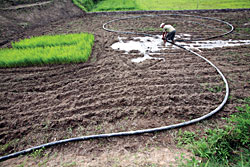 KIRAN PANDAY BOUNTYLESS: A rice planter irrigates his field in Naikap with water pumped out of a well after rains failed. |
The long winter drought this year was followed by monsoon rains that were delayed by nearly two months, devastated winter wheat and maize across Nepal and is expected to decimate rice harvests.
"We must consider ourselves lucky if we salvage even 50 per cent of rice production this year," says Harikrishna Upreti at the Nepal Agriculture Research Centre (NARC).
Rice accounts for half the total cereal production in Nepal, and with only 30 per cent of the paddy fields irrigated most farmers depend on the monsoon for their crop. Rice is also a water-intensive crop, and the delayed monsoon killed all paddy seeds that were being readied for transplanting.
"We are more than three weeks late for transplanting seedlings," Upreti says.
The report of the Ministry of Agriculture and Cooperatives (MoAC) shows that only 63 per cent of rice farms in the Himal, 60 per cent in the mid-hills and 36 per cent land in Tarai had been transplanted by end-July.
"The good news is that the plantation can be done till mid-August in Tarai and this week's rain has been helpful," says Hari Dahal, joint secretary at the MoAC.
He says about 95 per cent of the land in the Tarai and about 70 per cent in the mid-hills will be cultivated after this rain. "This makes us hopeful because three-fourths of rice production is in the Tarai, and it's still not too late," Dahal adds.
Nepal cultivates rice in 1.558 million hectares but only 654,360 hectares (42 per cent) land had been cultivated till the end of June. At NARC, agronomists are predicting a sharp drop in rice production and a severe food shortage this winter.
"The late transplanting has increased the cost of cultivation, and the seedlings are too old to yield a good harvest," he explains.
At the UN's World Food Programme (WFP) country director Richard Ragan says it is still too early to say how the monsoon rains will affect crop production. It is not just when the monsoon starts, but where and how much rain Nepal receives during the period that affects crop production, he says.
"Regardless of what happens to the monsoon crops, millions of people in Nepal are still facing severe food insecurity and need ongoing food assistance," Ragan told Nepali Times.
Meteorologists at the Weather Forecast Division predict the current monsoon pulse is robust and will continue into the weekend throughout the country. "The long spell of drought is over now," says Mani Ratna Sakya at the meteorology office.
Even without the delayed monsoon, Nepal was already reeling from an annual 133,000 ton food deficit from the winter drought. The country needs 5 million tons of grain a year of which half is for rice. About 90 per cent is met through domestic production. The combination of high food prices and drought over the last two years has doubled the number of food insecure people in Nepal. A joint assessment by the WFP, MoAC and the Food and Agricultural Organisation released in May states the winter drought reduced the production of wheat and barley by 14 and 17 per cent respectively.
"In the most-affected areas, one in two families is already skipping meals. If summer crops were to fail as they did in the winter, it would create a significant humanitarian crisis in Nepal," Ragan warns.
READ ALSO:
Rain and shine - FROM ISSUE #462 (31 JULY 2009 - 06 AUG 2009)
A visible hand - FROM ISSUE #462 (31 JULY 2009 - 06 AUG 2009)
Waiting game - FROM ISSUE #462 (31 JULY 2009 - 06 AUG 2009)
Risky business - FROM ISSUE #462 (31 JULY 2009 - 06 AUG 2009)


